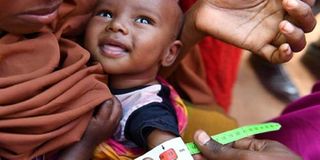Common nutrition beliefs that societies in TZ get wrong

A child's arm being measured to detect malnutrition. Photo | Internet
What you need to know:
An analysis on nutrition beliefs in the city of Dar es Salaam.
It is World Food Day today, and for Ms Neema Shosho, a Nutrition Officer with the World Food Program (WFP), it’s time for the Tanzanians to be part of the “Zero-Hunger Generation” and helping to build a nation that is food and nutrition-secure.
However, she says, achieving a nation that is well fed and healthy requires a society that is able to make the right food choices and has a better understanding of the concept of nutrition and malnutrition.
“…one might wonder why we still experience malnutrition while we grow enough food. Where do we go wrong? Is food security a silver bullet to attaining good nutrition?’’ Ms Shosho queries.
“Well, food availability is one key aspect to attaining good nutrition but it isn’t the only componen. There is a need for change of mindset among people in the society,’’ she explains.
Obesity is ‘actually’ being malnourished
Your Health went around the city interviewing people to try and get their opinions about malnutrition—to most of those interviewed, the images of starving children and people in hunger-stricken countries is what suits the description of malnutrition.
Mr Zebedayo Michael, 21, an accountant based in Kimara suburb, Dar es Salaam, believes that malnutrition means under-feeding. “Mmm...malnutrition actually means when a child has thin hair and swollen stomach or is starving with protruding bones,” he tells Your Health.
“In cities like Dar es Salaam, I can’t say we have malnutrition. Most people can afford food but in the upcountry where there is little food, there is a lot of malnutrition,’’ Mr Zebedayo adds.
But experts note that the concept of malnutrition is broad and doesn’t only refer to starvation, like what Mr Zebedayo understands it.
Mr Dennis Mbinga, a Nutritionist from Muhimbili National Hospital (MHN) says, “The society tends to think that malnutrition only occurs in children, not in older people. But also, most people believe that it only means feeding less, they forget that feeding on too much is also malnutrition.”
“When we talk of malnutrition, two things must be understood: There is what we call under-nutrition and over-nutrition. There are many cases of people who are overfed and eventually they suffer obesity—this is a typical case of over nutrition,’’ says Mr Mbinga.
“You have seen people with big tummies. This tells a lot about their eating/feeding habits. Feeding on huge quantities of carbohydrates means increasing the possibility of having a big tummy. You can now see that malnutrition is not simply a lack of what to feed on,’’ he tells Your Health in an interview.
“There is malnutrition in wealthy families. In this case, the problem is simple: That such families lack education on what exactly is right to feed on,’’ he says.
Mr Mbinga cites a past study done in Southern Highlands in Tanzania, where regions in that part of the country were found to lead in terms of cases of malnutrition cases.
“The research found out that these regions have a large supply of carbohydrate food, so the society tends to feed on more carbohydrates than any other types of food,’’ he says.
“For example, you will find a family feeding a child on potatoes for breakfast and for lunch. When it comes to dinner, the same child is given Ugali, which has the same nutrition benefits as potatoes,” he says.
“At times, society doesn’t believe malnutrition is a disease. Take this scenario in one of the regions I have researched on: There is a popular belief that when children have big tummies, it’s because their mothers saw something weird, such as a snake during pregnancy,’’ he recalls.
“That’s why there is need for mass education campaign on health and nutrition. People must understand the How’s and Why’s of feeding. That’s how we can create a healthy and well-fed nation,’’ said Mr Mbinga ahead of the World Food Day (WFD).
Pregnancy and nutrition
An expert in maternal health from Muhimbili National Hospital (MNH), Dr Ephraim Mrema says poor nutrition has far-reaching consequences on pregnant women.
“At times it’s unthinkable that you find pregnant women feeding on fried chips and soda. This affects their unborn child too. The women may give birth to low birth-weight babies,’’ he warns.
According to Tanzania’s current Demographic and Health Survey (TDHS), overweight and obese women fall in the 15-45 age brackets in Dar es Salaam. And this trend has increased by 8 per cent over a decade.
Surveys have also found that more than 20 per cent of women in the same age group, of 15-45 years, were overweight in the regions of Mbeya and Morogoro, Kilimanjaro as well as Arusha, Pwani and Iringa.
Making the right food choices
This year’s WFD focuses on Sustainable Development Goal-2: Zero Hunger, with the aim of promoting awareness and action for those who suffer from hunger and for the need to ensure food security and nutritious diets for all.
And for societies that have plenty of food, the challenge lies in making the right choices. Ms Lucy James, 34, a petty trader in Dar es Salaam says, “We fail to realise that when maize is processed, it loses protein.”
“But also, taking fruits and fat should not be a luxury. It should be a must. We normally spend much money at hospitals when we are sick while we could have spent the same amount to protect our health,” suggests Ms Lucy who admitted to Your Health that she has been receiving nutrition advice from various experts over the years.
Ms Lucy’s concern is well agreed by Dr Mrema, who says that at times feeding on more nutrients than what people actually need is not proper, as he emphasises on the concept of “over nutrition” and the rising trend of obesity in Tanzania.
“The main sign of over nutrition is being overweight or obese. But people with “undernutrition” can also be overweight if they eat a diet high in energy (calories), but low in other nutrients,” he explains.
“Signs of malnutrition in children can include failure to grow at the expected rate and changes in behaviour, such as appearing unusually irritable, sluggish or anxious,’’ he says.
“We usually advise people to eat a variety of foods from the four main food groups; including fruits and vegetables, rice, potatoes, pasta and other starchy food, some milk and dairy foods, as well as some meat, fish, eggs, beans and other non-dairy sources of protein,’’ he says.
The need for a broader understanding
The remarks made by Ms Shosho at the beginning of this story, are a call for society to reflect on the right options. But also, a reminder to governments to start investing heavily in educating society on the right food choices.
In further remarks, she says, “We also shouldn’t forget that food security doesn’t necessarily translate to nutrition security. We still experience higher levels of malnutrition specifically undernutrition in areas that produce plenty of food.”
Ms Shosho suggests that preventing all forms of malnutrition, a multisectoral approach is needed. “We must work in collaboration and ensure food is available and not just any food, dietary diversity is key,” she says.
“There are many questions as to whether to attain dietary diversity is affordable and realistic…, the answer is yes. I mean it’s a matter of changing our mindset and not entertaining myths,’’ she says.
“It is equally important to ensure that communities are educated and economically empowered because there is a clear link between poverty and malnutrition. A household that is poor will not be able to purchase or grow a variety of food or access health services, allowing malnutrition to prevail,” she explains.
“In some communities, gender inequality and social norms also contribute to malnutrition. In Tanzania for instance, there are communities where women are not allowed to own resources or make any decisions related to choices of food as every key decision regarding household resources is made by a man.”


